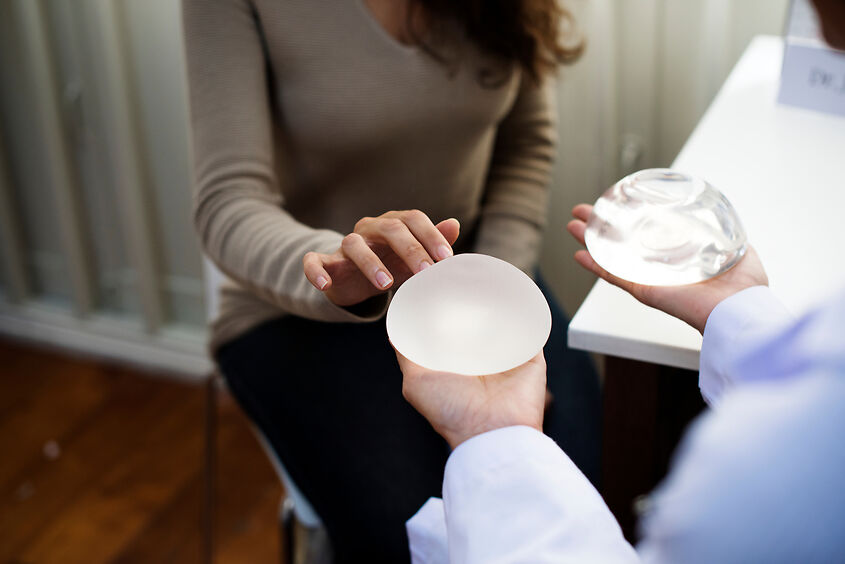Welcome to the realm of breast augmentation, where the choice between silicone and saline implants is a pivotal decision in the pursuit of aesthetic enhancement. As we delve into this captivating topic, guided by the expertise of renowned plastic surgeon Dr. Josh Waltzman, we uncover the nuances that distinguish these two implant types. Whether you're contemplating a procedure or simply curious about the ever-evolving field of cosmetic surgery, this exploration is your backstage pass to the world of silicone versus saline breast implants.
 Photo Credit: Courtesy of Shutterstock
Photo Credit: Courtesy of Shutterstock
Exploring Key Differences Between Silicone and Saline Breast Implants
Silicone and saline breast implants share commonalities while displaying distinctive features. Both variants consist of a silicone shell that comes into contact with the surrounding tissues, irrespective of the implant type. The differentiating factor lies in the fillings: silicone implants are filled with a cohesive, silicone gel, whereas saline implants are filled with saline or salt water. Notably, the latest generation of silicone breast implants has earned the colloquial moniker "gummy bear implants" owing to their highly cohesive nature. This unique characteristic ensures that even if there is a minor tear in the implant shell, the silicone gel remains securely contained within the implant, eliminating the risk of leakage. It is important to note that silicone and saline implants are effective options, each capable of delivering aesthetically pleasing results.
Patients with limited breast tissue may discover that silicone implants offer a more natural feel and potentially reduce visible rippling along the sides of the breast. Also, there is a broader array of choices available in the realm of cohesive silicone gels, presenting patients with varied options compared to the singular type associated with saline breast implants. A significant contrast lies in the insertion process – saline implants are introduced into the body deflated and filled with saline afterward. In contrast, silicone implants come pre-filled to a predetermined volume. This distinction underscores the diverse considerations patients can explore when making decisions tailored to their unique preferences and anatomical considerations.
Which Prevails in Popularity – Silicone or Saline Implants?
In my practice, silicone implants are much more commonly used. In my experience, a silicone implant often emerges as a secure choice for the majority of patients, delivering a remarkably natural feel to the breast. It mimics the responsiveness of normal breast tissue and tends to exhibit significantly less visible rippling compared to saline implants. If an individual already possesses a considerable amount of breast tissue and simply requires a modest volume boost, the choice between a saline or silicone breast implant might be inconsequential. In such cases, the implant is likely to be imperceptible both visually and tactilely beneath the existing breast tissue. However, if the patient has very small breasts, then my personal preference is usually for a silicone breast implant.
Longevity Unveiled: Lifespan and Maintenance
The lifespan of both silicone and saline implants is fairly similar, as indicated by most studies revealing that women with breast implants typically undergo some form of surgery every 10-15 years. As a general principle, if the implant is functioning well and causing no issues, there is typically no need for surgical intervention. In simpler terms, the adage "if it's not broken, don't fix it" aptly applies. It's important to acknowledge the inherent risks associated with any surgery, which could potentially introduce problems that weren't initially present. A noteworthy distinction is that surveillance imaging is necessary for silicone implants.
The FDA now advises women with silicone breast implants to undergo an MRI 5 to 6 years after the initial implantation, followed by subsequent scans every 2 to 3 years for as long as the implants are retained. This surveillance is crucial for detecting any potential ruptures. Due to the cohesive nature of silicone implants, it can be challenging for most women to discern a small rupture in the implant's shell. This is where the MRI proves invaluable in identifying what we term as a "silent rupture." Unlike saline implants, which promptly deflate when there is a small hole in the shell, causing an immediate reduction in breast size over one to two days, silicone implants don't exhibit such immediate signs. However, with responsible monitoring through regular MRI imaging, silicone implants are deemed safe, effective, and can offer years of satisfaction for the patient.
 Photo Credit: Courtesy of Shutterstock
Photo Credit: Courtesy of Shutterstock
The Touch Test: Comparing the Outcomes of Silicone and Saline Breast Implants
Silicone and saline implants exhibit distinct tactile sensations, yet it's crucial to recognize that the feel can differ outside the body compared to when placed within the breast. When considering breast augmentation, I frequently find that silicone implants offer a more natural touch with reduced potential for visible rippling. In my experience, silicone implants often contribute to a seamless integration, providing a cohesive sensation where the implant feels like an integral part of the breast. This is in contrast to saline implants, where patients sometimes perceive the implant as distinct from the breast tissue. Additionally, complaints about a sloshing sensation on the chest are not commonly reported with silicone implants, offering another point of distinction between the two options.
Another significant difference between silicone and saline implants is that silicone implants can now offer enhanced upper-pole fill and projection in comparison to saline implants. This is attributed to the unique properties of highly cross-linked silicone, allowing for increased projection in the upper half of the breast, particularly when patients are in a standing position. Both older silicone implants and saline implants often experience issues such as collapse or diminished projection in the upper half of the breast.
Despite all these considerations, the ultimate outcome heavily relies on the preoperative planning and the surgical skill of your chosen surgeon. Whether using silicone or saline, the potential exists for achieving either an unnatural and displeasing result or a beautifully balanced aesthetic outcome.
Breakings News: The Latest Advancements and Innovations in Silicone and Saline Implant Technology
In recent years, specifically in the United States, there haven't been notable breakthroughs in silicone or saline breast implant technology. The current generation of "gummy" silicone implants, a significant advancement utilized for the past 8-9 years, represents the most recent progress. However, there's excitement on the horizon, with Europe and South America spearheading innovations currently undergoing FDA trials for potential introduction in the United States. Among these advancements are lightweight silicone implants and micro-textured silicone implants, which hold promise for even more favorable outcomes and reduced risk of capsular contracture. The future holds great promise, and I'm thrilled to be at the forefront of these exciting developments in the field of cosmetic surgery.
If you're considering this transformative journey, take the next step towards achieving your aesthetic goals. Reach out to Dr. Josh Waltzman today for a personalized consultation, guiding you toward the ideal choice that aligns with your unique desires and ensures a beautifully balanced outcome.
For more information, visit Dr. Josh Waltzman's social media:
























